EQUALITY@WORK ONLINE PLATFORM
What is the EQUALITY@WORK online platform?
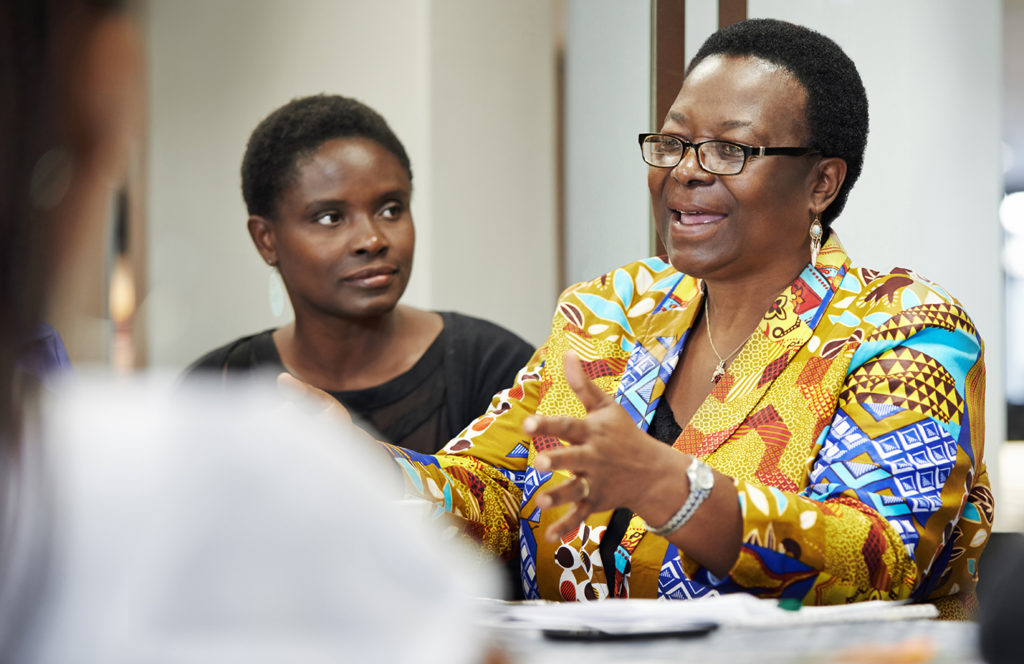
The EQUALITY@WORK online platform is a system of gender equality indicators for private sector companies that seeks to characterize, quantify and provide evidence regarding the degree of equality and gender gaps in the workplace. The evidence is obtained through the generation of quantitative and qualitative information about the organizations that participate in the Gender Equality Seal (GES) programme or are willing to implement gender equality policies.
Through the regular observation of KPIs, this platform seeks to create an up-to-date and comparable source of information that allows for the monitoring of organizations that are in the process of achieving higher levels of gender equality and, ultimately, reducing gender gaps. The tool helps to build a baseline, set goals based on gender equality benchmarks and monitor progress of the evolution of gender gaps.
- Intuitive platform, easy to use, highest security standards, fully web-based.
- Integrates quantitative and qualitative information to reveal and characterize gender gaps, which are translated into a set of KPIs.
- Makes it possible to conduct a self-assessment with simultaneous integration of personnel opinions regarding gender equality in the workplace.
- Produces an automated Gender Gap Report with a battery of more than 50 KPIs that measure gender gaps, and simultaneously integrates the results of the self-assessment and personnel opinion survey.
- Each indicator has a benchmark, providing a BSC for gender equality in the organization so informed decisions can be made regarding gender equality.
- Allows organizations to establish concrete goals on the path to gender equality and measure their progress.
- Provides key inputs for establishing an Organizational Diagnosis with a gender perspective, as well as formulating a more assertive Action Plan to bridge strategic gender gaps.
- It features a technical support team that guarantees the accuracy of the information uploaded by delivering a validation process. This team will also analyse the information to provide key recommendations for the formulation or re-orientation of the action plan.
Who uses it?
The main users of EQUALITY@WORK are organizations that wish to create a baseline for their situation regarding gender equality or those organizations that have been recognized with a Gender Equality Seal and want to monitor their gap-closing processes. In this sense, it is they who contribute the information needed for the assessment of individual, local, regional and global indicators.
WHAT ARE THE MODULES OF THE PLATFORM?
- Organization profile and productivity (OP)
- Personnel profile (PP)
- Recruitment, selection and hiring (RSH)
- Professional development and performance (PDP)
- Remuneration (R)
- Prevention of harassment in the workplace (PH)
- Work-life balance with shared social responsibility (WLBS)
- Communication (COM)
- Supply Chain (SC)
Each module is linked to basic gender equality indicators or KPIs that define the components to be analysed.
(OP) ORGANIZATION PROFILE AND PRODUCTIVITY
This set of indicators comprises a number of variables and facts about a company or organization including location, size, industry, type of organization and financial metrics. It also contains gender-sensitive productivity indicators such as absenteeism and turnover.
- General descriptive data on the company or organization
- Financial metrics (Return on Equity, Return on Invested Capital, Return on Sales and others)
- Gender-sensitive productivity indicators
(PP) PERSONNEL PROFILE
Gathers the perspective and experience of employees in a company or organization, specifically pertaining to the presence or absence of women in relation to men on a variety of levels (e.g. the ratio of men and women in leadership positions, departments, or members of the Board of Directors).- General ratio of men and women in a company or organization (participation rate by sex)
- Horizontal distribution (sex-disaggregated by occupation and department)
- Vertical distribution (sex disaggregated by level of responsibility)
- Gender gap in management and other positions
- Distribution of employees by type of contract
- Distribution of employees by type of workday
(RSH) RECRUITMENT, SELECTION AND HIRING
Information which enables the evaluation of recruitment, selection and hiring processes in companies from a gender perspective, assessing whether they produce gender gaps.- Recruitment and selection
- Hiring
- Personnel assessment/perception of recruitment, selection, and hiring processes
(PDP) PROFESSIONAL DEVELOPMENT AND PERFORMANCE
Assesses whether career advancement processes in companies and organizations offer equal opportunity for men and women, or if a gender bias exists. In addition, this pillar focuses on evaluating whether women and men participate equally in the ongoing training opportunities that companies or organizations offer (internally or externally), and which is often fundamental for career advancement and development- Promotion
- Training and skills development
- Employee perception on the degree of equality of professional development policies (promotion and training)
(R) REMUNERATION
Compiles information that allows for evaluation of whether the remuneration that women and men receive from companies and organizations in their receipt of fair wages according to the principle of equal pay for work of equal value.
- Remuneration
- Personnel assessment/perception of wage policy
(PH) PREVENTION OF SEXUAL AND SEX-BASED HARASSMENT IN THE WORKPLACE
Compiles information needed to measure the existence or lack of measures to prevent and act upon cases of sexual and sex-based harassment in the workplace, the ratio of cases that occurred to those reported, and the impact of addressing and resolving those cases.
- Sexual and sex-based harassment
- Personnel assessment/perception of harassment prevention policy
- Personnel assessment and degree of knowledge of the effectiveness of mechanisms that companies or organizations facilitate to prevent and act against this type of gender-based violence (sex-based and sexual harassment)
(WLBS) WORK-LIFE BALANCE WITH SHARED SOCIAL RESPONSIBILITY
Assesses whether work-life balance policies with shared responsibility offer equal opportunity for men and women, or if a gender bias exists. Measures the existence, degree of knowledge and rate of utilization of work-life balance measures.
- Paid leave (maternity and paternity)
- Unpaid leave (temporary leave of absence to care for dependents and other measures)
- Flexible working arrangements including workspace and schedule
- Personnel assessment/perception and degree of knowledge of the work-life balance policy
(COM) MARKETING AND COMMUNICATION
This set of indicators measures the degree of gender equality in the management of internal and external communications and marketing strategies- Internal communication without gender bias
- Assessment/perception of communication and channels/mechanisms for internal communication
- External communication and marketing strategies without gender bias
- Assessment/perception of communication and channels/mechanisms for external communication
(SC) SUPPLY CHAIN
Assesses at what extent gender equality crosscuts supply change management policies and practices including gender responsive procurement, how diverse is the supply base and how are women-owned businesses included.- Gender equality in suppliers’ policies and communication of commitments
- Share of women-owned businesses in the supply base
- Gender equality commitments in the supply base
Based on the information provided by the organisation on its structures, realities and practices, EQUALITY@WORK generates automated gender equality impact KPIs that allow for the assessment of the organisation in terms of gender gaps and the degree of equality achieved.

How do you use the EQUALITY@WORK online platform?
Three sources of information, or tools, feed into the platform:
1. Basic information form
Completed by the organization. Obtains general information about the organization (descriptive data).
2. Gender Equality Self-Assessment (59 Questions)
Seeks to obtain information about the gender equality reality of the organization: personnel data, description of management methods and human resources policies.
3. Gender Equality Personnel Opinion Survey (28 questions – 15 minutes)
Obtains information about the personnel’s assessment/perception of the organization regarding gender equality, effectiveness of policies and integration of the gender perspective into human resources management practices. The organization invites employees to fill-out the survey directly above through the platform.

Who completes the EQUALITY@WORK basic information form and Gender Equality Self-Assessment?
Who completes the EQUALITY@WORK Gender Equality Personnel Opinion Survey?

Steps to use the EQUALITY@WORK online platform
To begin using the platform, the interested organisation should contact UNDP. Once this occurs, the process will move forward in the following manner:
The organisation and the person appointed to be the contact focal point get credentials to access the system.
Interest in developing a baseline organisational analysis from a gender perspective should not only follow up on gap closing processes already underway, but also be promoted from the organization’s top management. Hence the importance of senior management knowing the objectives, structure and methodology used in the EQUALITY@WORK platform, which will enable them to commit to its effective implementation.
The person who has been endorsed or approved by organization senior management must be trained in the utilization of the online platform in order to complete the EQUALITY@WORK tools. The training lasts two to two and a half hours.
Once the person assigned by the organisation is trained, permanent remote support will be provided by UNDP. This support aims to validate the information gathered, resolve questions and ensure adequate use of the tools throughout the process of entering the information.
The EQUALITY@WORK platform has automated software that processes the information entered by the organization to create a series of indicators that reflect the organisation’s situation regarding gender gaps under the pillars. These indicators are synthesized in a Gender Gap Report, which, based on a comparison with a benchmark considered optimal, shows the organization its current situation regarding gender equality. UNDP will give a presentation with recommendations for improvement according to the results obtained.
Reports delivered by the EQUALITY@WORK online platform
The online platform delivers the following products to the organisation immediately after the information tools are completed:
1. Gender Equality Index (GEI)
Is a composite index that measures the relative performance of the company against a set of benchmarks established to measure the degree of gender equality of the organisation. Each of the benchmarks has a range for positive, intermediate, and negative values. A score of a 100 is given when the value for the organisation scores within the positive range, and 0 when scores within the negative range. The overall index is calculated on a simple average of all scores giving the same relative weight to all the benchmarks within the same dimension or pillar and giving differentiated weights to each dimension depending on its complexity.
2. Gender Gap Report
Based on the results of the organisation’s self-assessment, basic information form and Personnel Opinion Survey, the online platform generates up to 52 automated gender gap indicators divided among the pillars that reflect the organisation’s situation under each of them.
The report shows the result of the Gender Equality Index (GEI) and provides an outlook of all the indicators by using a tree map. It also uses a three-band color system that helps to identify indicators with good (green), intermediate (yellow) or negative performance (red).
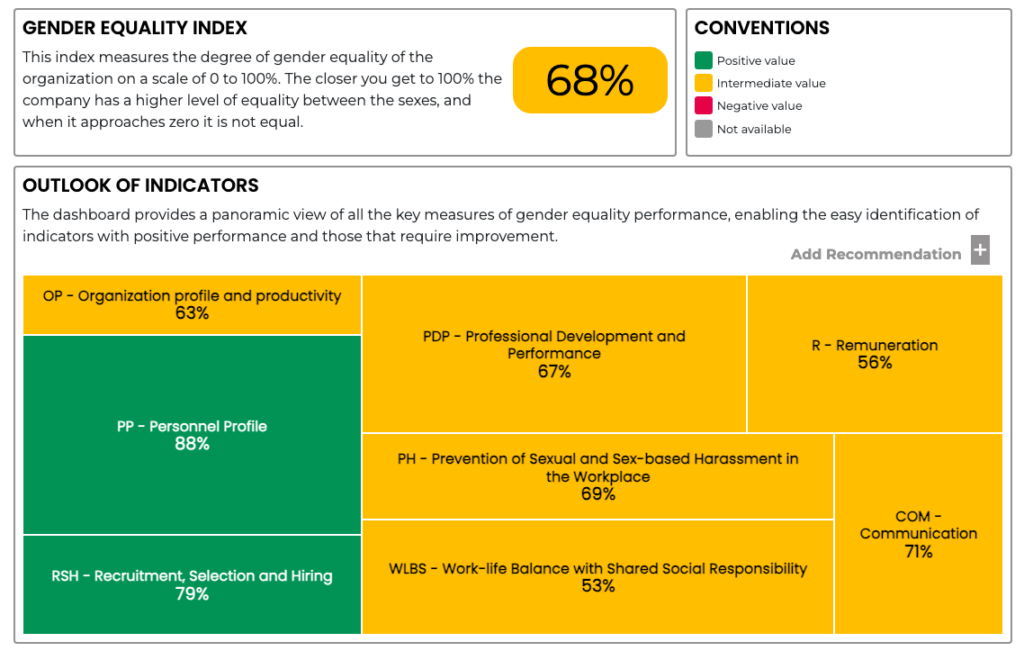
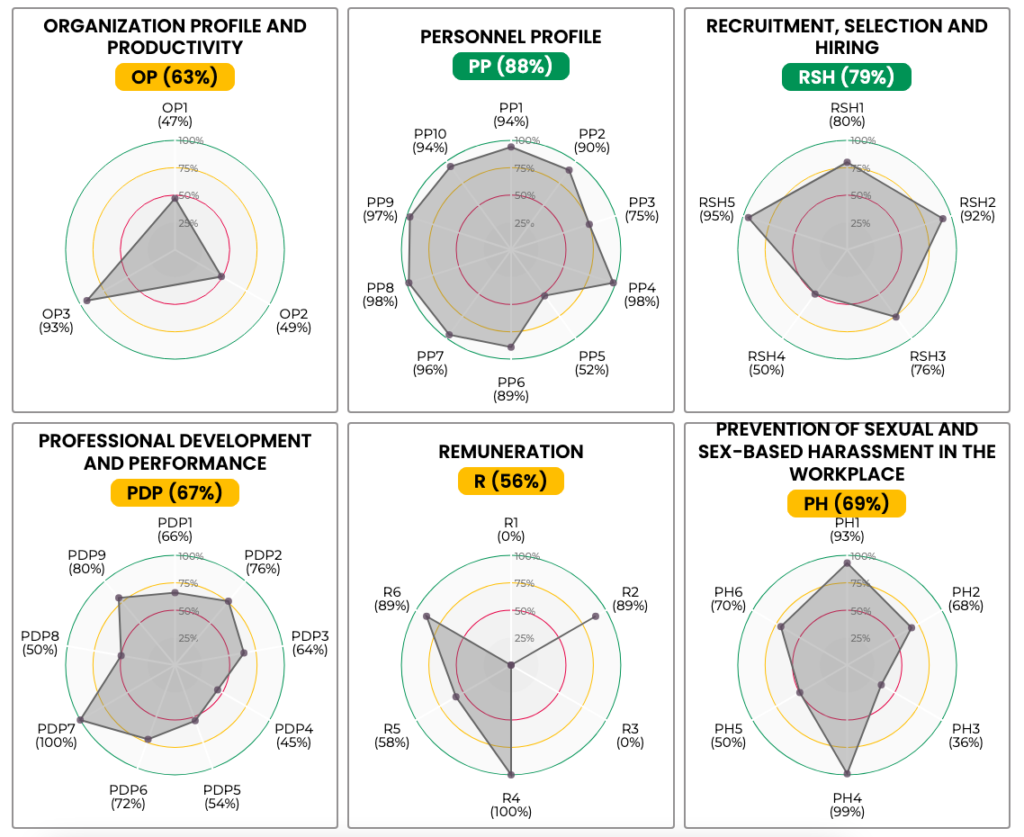
The platform also presents a summary for each pillar or component with the results of the Gender Equality Index (GEI) through a radar or spider chart.
It then breaks down the indicators pillar by pillar, defining each gap that was measured, the purpose of the indicator, and the indicator’s result. It graphically shows the values disaggregated by sex, or any other applicable variables.
One of the central elements of this report, when determining an organisation’s situation against each of the indicators, is the visual representation of the “speedometer”, which indicates whether the organisation is in a positive (green), intermediate (yellow) or negative (red) position depending on the indicator range and the optimum reference value. This graphical tool allows the organization to quickly identify the areas of improvement to prioritize with a view to progress in the effective closure of gender gaps.
By clicking the bar with the summary of the indicators, which contains the benchmarks for the interpretation of the indicator, the organization have access to all the indicators of a particular component.
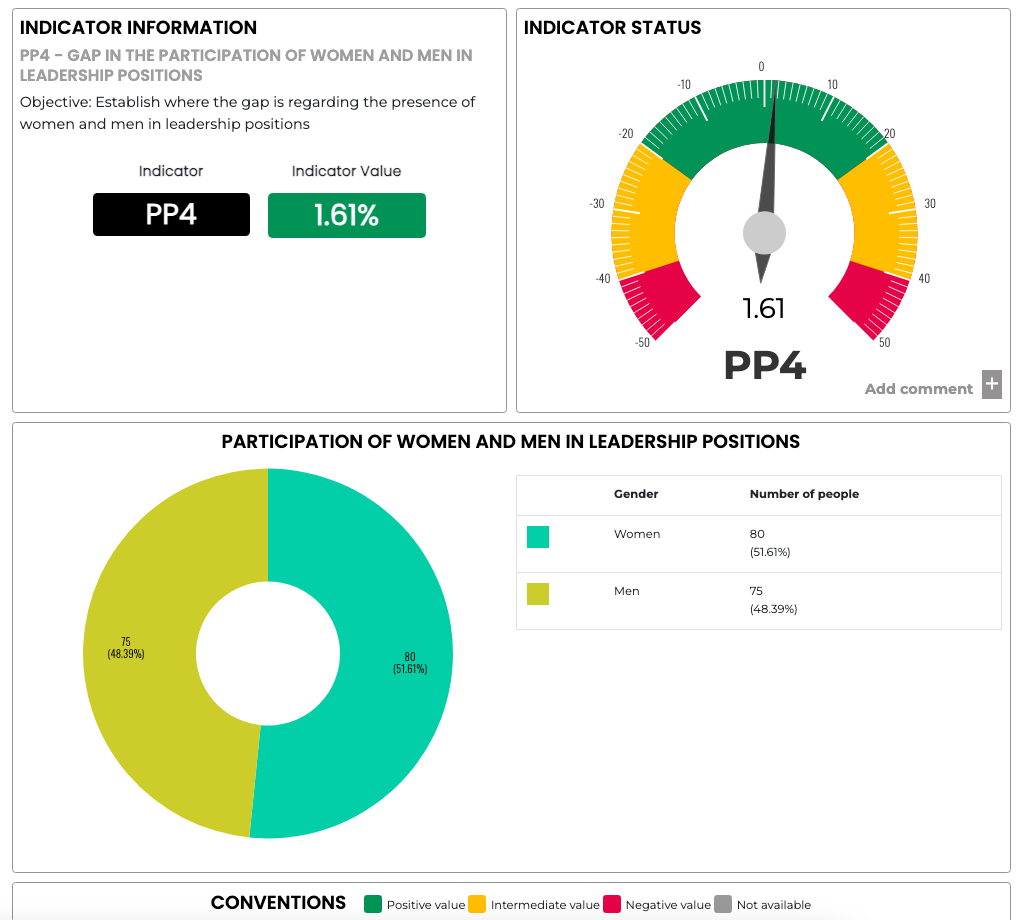
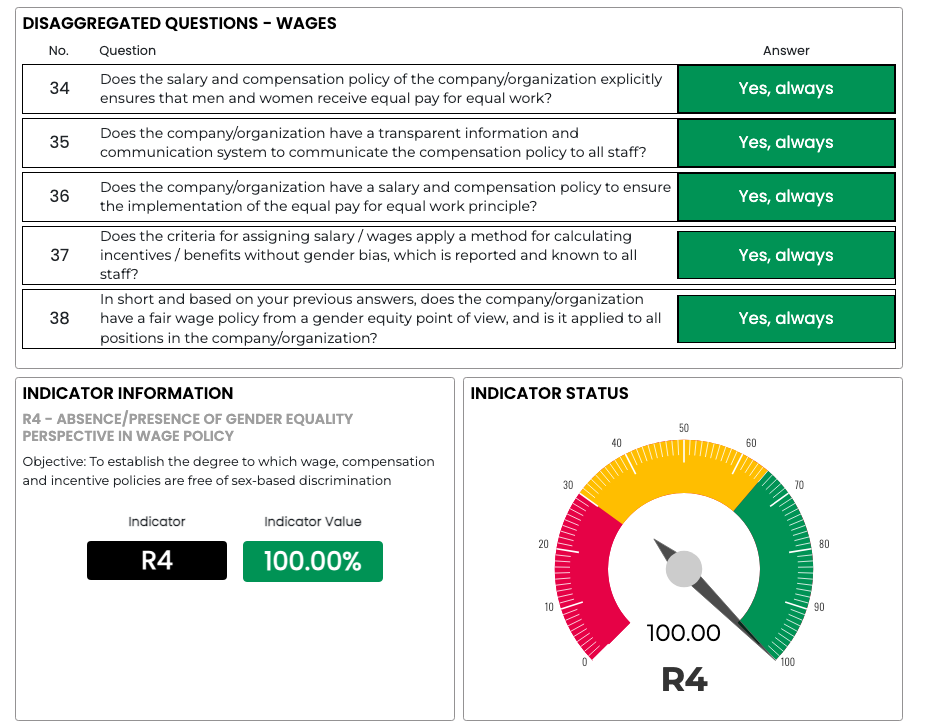
3. Gender Equality Management Self-Assessment Report
The report is produced with the information provided for the employment policies section of the self-assessment. This qualitative information is of vital importance when evaluating the effectiveness of the policies implemented in the organization by knowing and verifying, in a strictly confidential way, whether it is necessary to delve more deeply into the aspects reflected in the survey. The results of the self-assessment will help the organization to compare the effectiveness and degree of knowledge of its policies according to the opinions expressed by its employees. The results are shown following the structure of the pillars. A graphical synthesis of the set of responses for each of the pillars is also included.
4. Employee opinion survey report
This report is produced with the data gathered from the Employee Opinion Survey. It contains demographic data of characterization of the personnel who answered the survey. Each of the questions can be filtered either by pillar or component, or by demographic criteria such us sex, age, ethnic group or disability.
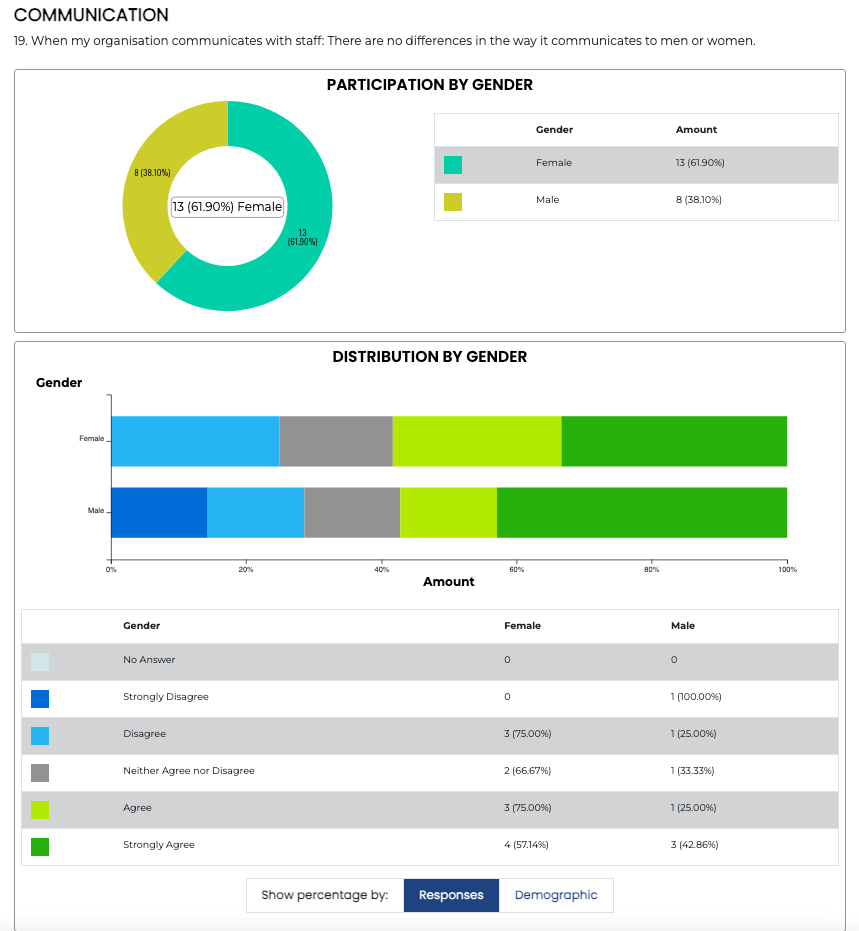
Note: The English version of this document was produced in collaboration with Christina de Paris and Shannon Kirby, UN Online Volunteers.

